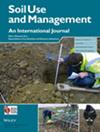作为土壤结构脆弱性指标的有机碳-粘土比,这是一个关注土壤结构状况的指标
IF 3.7
3区 农林科学
Q1 SOIL SCIENCE
引用次数: 0
摘要
土壤有机碳与粘土比(SOC:clay)是用于土壤质量管理的一个指标。例如,在瑞士和英国,SOC:粘土比的临界值被确定为土壤结构非常好(1:8)到退化(1:13)的标志。然而,Poeplau 和 Don 最近在《土壤利用与管理》上发表的一篇文章指出,根据他们的观察,德国的沙质土壤和重粘土往往分别显示出非常高和非常低的 SOC:clay 比率,因此这一指标具有 "强烈的偏差和误导性"。他们提出了一个替代指标,该指标基于某一地区实际 SOC 与预期 SOC 水平之比。我们对该建议进行了评论,认为由于该方法忽略了土壤结构质量,因此无法为土壤健康提供适当的 SOC 水平,并可能导致 SOC 高度贫瘠的土壤被归类为 "良好 "土壤。另一方面,SOC:粘土比确实能反映土壤结构状况,提供结构脆弱性指数,这是一项独立于当地土壤管理条件的关键功能。当发现土壤的结构脆弱性较高时(如 SOC:clay 比率所示),应调查该地点的种植方法,并考虑如何提高 SOC 含量。只有在观察到的平均结构质量不符合当前阈值的情况下,才可能需要重新评估结构条件阈值。本文章由计算机程序翻译,如有差异,请以英文原文为准。
The organic carbon‐to‐clay ratio as an indicator of soil structure vulnerability, a metric focused on the condition of soil structure
The soil organic carbon to clay ratio (SOC:clay) is a metric used in soil quality management. In Switzerland and the United Kingdom, for example, threshold values for SOC:clay ratios have been determined to indicate very good (>1:8) to degraded (<1:13) soil structures. A recent article in Soil Use and Management by Poeplau and Don, however, suggested that this metric is ‘strongly biased and misleading’, based on their observation that German sandy soils and heavy clay soils tend to show very high and very low SOC:clay ratios, respectively. An alternative metric was proposed based on the ratio of actual SOC to expected SOC level for a considered area. We offer a commentary on the proposal, arguing that because soil structure quality is overlooked by the approach, it fails to provide appropriate SOC levels for soil health and could lead to soils with highly depleted SOC being classified ‘good’. The SOC:clay ratio, on the other hand, does address soil structure condition, providing a structure vulnerability index, a key function independent of local soil management conditions. When soils are found to have high structure vulnerability, as indicated by the SOC:clay ratio, the cropping practices at the site should be investigated and ways to increase the SOC content considered. Structure condition threshold values may only need to be reassessed if it is shown that the average structure quality observed is not in conformity with the present thresholds, which would be expected for some soils, such as Andosols.
求助全文
通过发布文献求助,成功后即可免费获取论文全文。
去求助
来源期刊

Soil Use and Management
农林科学-土壤科学
CiteScore
7.70
自引率
13.20%
发文量
78
审稿时长
3 months
期刊介绍:
Soil Use and Management publishes in soil science, earth and environmental science, agricultural science, and engineering fields. The submitted papers should consider the underlying mechanisms governing the natural and anthropogenic processes which affect soil systems, and should inform policy makers and/or practitioners on the sustainable use and management of soil resources. Interdisciplinary studies, e.g. linking soil with climate change, biodiversity, global health, and the UN’s sustainable development goals, with strong novelty, wide implications, and unexpected outcomes are welcomed.
 求助内容:
求助内容: 应助结果提醒方式:
应助结果提醒方式:


